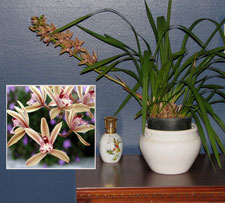Resource Library
Plant of the Week: Orchid, Cymbidium
The University of Arkansas System Division of Agriculture does not promote, support or recommend plants featured in "Plant of the Week." Please consult your local Extension office for plants suitable for your region.
Plant of the Week
Cymbidium Orchid
Latin: Cymbidium hybrid

The big box stores take a lot of grief for the changes they have wrought on established business and our society, but from a horticultural standpoint their garden shops have been responsible for reintroducing the buying public to orchids.
Their volume approach makes it feasible to offer a wide array of fairly pricy orchids that had almost disappeared from commerce, being relegated to a few specialty growers and mail-order sources. For that, I say thanks.
Cymbidium orchids, like most of their brethren, are complex hybrids derived from six or so species native to tropical areas in China and on the south slope of the Himalayas in Nepal and India. Most grow in humus-rich soil on steep, well drained slopes instead of as epiphytes nestled on tree branches.
Cymbidiums have evergreen, strap-shaped foliage arising from swollen pseudo-bulbs growing at the soil surface. Leaves are usually about 2 feet long with the plant form reminiscent of that of a daylily. Most hybrids are late winter or spring blooming, but some are now available with blooms through most of the summer and fall. Upright spikes are capable of reaching three feet tall but miniature forms are also available.
The five tepaled-blooms are 2 inches to 3 inches across with a prominent mouth-like lip often colored differently than the surrounding tepals. Some hybrids are fragrant but the one shown is not. Flowers usually have a greenish or brownish undertone mixed with white, beige, yellow or red. The blooms are long lasting, remaining attractive for a month or more.
Our socio-centric culture often leads one to conclude the ancient world was sitting on its hands waiting to be enlightened by European explorers and merchants. Such delusions are hard to shake and wholly unfounded. For example, cymbidium orchids were one of the favorite plants of educated Chinese at least as far back as Confucian times, around 500 BC. During the Southern Song dynasty (1127 - 1279), two books on growing cymbidiums were prepared.
Most orchids have a Dr. Jekyll/Mr. Hyde personality; beautiful flowers but ugly foliage. Cymbidiums though have spiky, more interesting foliage than most orchids. By accumulating a few to many different kinds of orchids - depending on your level of addiction - and giving them place to hang out during their down time, they will reward you with beautiful flowers every year.
My cymbidium summers outside in the shade garden with the other houseplants. I will repot it this spring using a coarse fir bark that has more in common with mulch than a normal potting medium. A six- to eight- inch pot works well for these terrestrial plants. Slow release fertilizer applied as the plants begin new growth, followed by a second application in mid summer, will keep them growing. The shade garden irrigation does the watering. Direct, midday sun can scorch the foliage.
In the fall, it goes into my greenhouse where it huddles in the cold with the other orchids awaiting warmer days. My greenhouse dips to 45°F at night and seldom rises above 70° during sunny wintertime days. These are colder temperatures than orchids prefer but my intent is to overwinter them, not force flowers. Yet, cymbidiums like the cold greenhouse and send up a flower spike even at these cold temperatures. If I didn’t have a greenhouse, I would keep it in a sunny bedroom that is kept on the cool side.
By: Gerald Klingaman, retired
Extension Horticulturist - Ornamentals
Extension News - March 16, 2007
The University of Arkansas System Division of Agriculture does not maintain lists of retail outlets where these plants can be purchased. Please check your local nursery or other retail outlets to ask about the availability of these plants for your growing area.